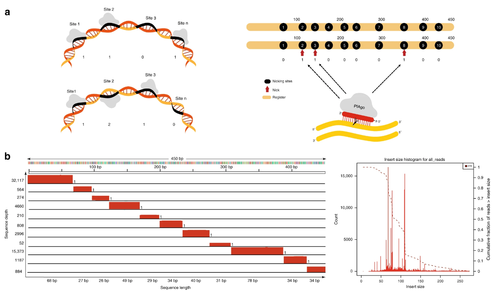Difference between revisions of "DNA Punch Cards for Storing Data"
(→Results) |
|||
| (One intermediate revision by the same user not shown) | |||
| Line 5: | Line 5: | ||
==Results== | ==Results== | ||
Native DNA can be used as punch cards due to the fixed-nature of native DNA sequences. Information can be encoded by nicking the backbone of double-stranded native DNA, enabling operations such as random access and in-memory computation. This is achieved by parsing files as n-bit strings which are subsequently converted into nicking positions that serve as registers. At each register's position, a nick indicates a value of 1, and the absence of a nick indicates a value of 0. For example, a string of 01001000 would have nicks at positions 2 and 5. Since the bit 0 doesn't require any reactions in this nick-based system, it halves the size of recorded files. The following figure shows the reading and writing of encoded data: | Native DNA can be used as punch cards due to the fixed-nature of native DNA sequences. Information can be encoded by nicking the backbone of double-stranded native DNA, enabling operations such as random access and in-memory computation. This is achieved by parsing files as n-bit strings which are subsequently converted into nicking positions that serve as registers. At each register's position, a nick indicates a value of 1, and the absence of a nick indicates a value of 0. For example, a string of 01001000 would have nicks at positions 2 and 5. Since the bit 0 doesn't require any reactions in this nick-based system, it halves the size of recorded files. The following figure shows the reading and writing of encoded data: | ||
| + | |||
| + | [[File:DNA_Punch_Card.png|500px|thumb|center| Figure 2a and 2b from <ref name=naturednapunchcards/>]] | ||
==References== | ==References== | ||
Latest revision as of 21:22, 13 July 2022
Overview
Synthetic DNA storage systems draw significant interest in the scientific community due to the potential for high storage density and stability. These systems are costly, have a high read/write latency, and are prone to errors. However, these issues can be resolved through the use of native DNA punch cards.[1].
Results
Native DNA can be used as punch cards due to the fixed-nature of native DNA sequences. Information can be encoded by nicking the backbone of double-stranded native DNA, enabling operations such as random access and in-memory computation. This is achieved by parsing files as n-bit strings which are subsequently converted into nicking positions that serve as registers. At each register's position, a nick indicates a value of 1, and the absence of a nick indicates a value of 0. For example, a string of 01001000 would have nicks at positions 2 and 5. Since the bit 0 doesn't require any reactions in this nick-based system, it halves the size of recorded files. The following figure shows the reading and writing of encoded data:
